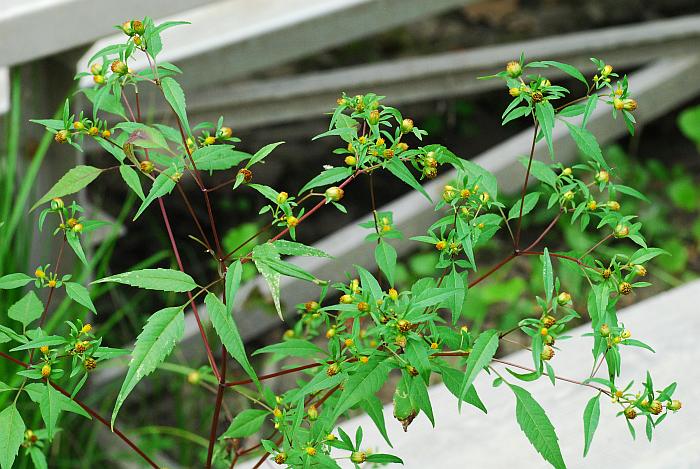Bidens discoidea (Torr. & A. Gray) Britton
Few-Bracted Bur Marigold

Native
CC = 8
CW = -3
MOC = 28
© SRTurner
Bidens discoidea (Torr. & A. Gray) BrittonFew-Bracted Bur Marigold | |
 |
Native CC = 8 CW = -3 MOC = 28 |
© SRTurner |
|
Family - Asteraceae/Heliantheae Habit - Annual forb, terrestrial or occasionally epiphytic, usually taprooted. Stems - Loosely ascending to erect, to 80 cm, rooting at lower nodes, 4-angled (the angles rounded), usually branched, often purplish, glabrous.
Leaves - Opposite, petiolate, trifoliolate. Petioles to 5 cm long, with narrow adaxial groove. Blades 3-15 cm long, broadly ovate-triangular in outline, usually all once ternately (pinnately) compound with 3 discrete leaflets, these lanceolate to obovate, to 10 cm, mostly angled at the base, each with a well-developed stalk, tapered to a sharply pointed tip, the margins usually sharply and relatively coarsely toothed, the surfaces glabrous or the undersurface sparsely to moderately pubescent with minute, antrorse hairs. Serrations of leaflet margins often with minute whitish apices. Lateral leaflets with petiolules 1-3 mm long. Terminal leaflet with a petiolule to 2cm long.
Inflorescence - Terminal heads or loose clusters of heads.
Heads - Discoid. Involucre with the outer series of 3-5 bracts 8-25 mm long, ascending to spreading, leaflike, linear to narrowly oblanceolate, the margins entire and usually glabrous, the outer surface glabrous or sparsely and minutely hairy, especially toward the base; the inner series of 5-7 bracts 4-7 mm long, oblong to narrowly lanceolate, glabrous. Chaffy bracts narrowly oblong to oblong, usually with broad, yellowish margins but purplish-tinged at the tip.
Flowers - Ray florets absent. Disk florets 10-20 per head, the corollas 1.5-2.0 mm long, 5-lobed, yellow, glabrous. Pappus rarely absent, usually of 2 awns 0.5-2.0 mm long, these with upward-pointed barbs, erect to slightly spreading at fruiting. Stamens 5, partially exserted, fused to basal 1/3 of the corolla tube. Anthers purplish, 0.7 mm long. Style exserted, bifurcate, yellow at the stigmas.
Fruits - Achenes 3-6 mm long, 2-awned, wedge-shaped to narrowly oblong-obovate, often slightly 3- or 4-angled (1 or both faces sometimes with a broad, low longitudinal angle or ridge), the angles with minute, stiff, ascending hairs, the faces reddish brown to black, moderately to densely pubescent with fine, more or less appressed hairs.
Flowering - August - October. Habitat - Wet ground, swamps, bottomlands, pond margins. Lookalikes - Bidens frondosa, B. tripartita, and B. vulgata appear similar, having flowering heads which lack rays florets. Origin - Native to the U.S. Other info. - This species can be found primarily in the Ozark section of Missouri. It also occurs in widely scattered locations throughout the eastern half of the U.S., and into Canada. It is an inconspicuous plant, having flowering heads which lack ray florets. Along with these discoid heads, the key to identification is that the outer, spreading involucral bracts are few in number, usually less than 5, and have glabrous margins. The heads are also somewhat smaller than those of other closely related species. Photographs taken in Brown Summit, NC., 9-8-02 (DETenaglia); also at Duck Creek Conservation Area, Stoddard County, MO, 10-18-2017; and at Washington (MO) Riverfront Park, Franklin County, MO, 9-20-2019 (SRTurner). |